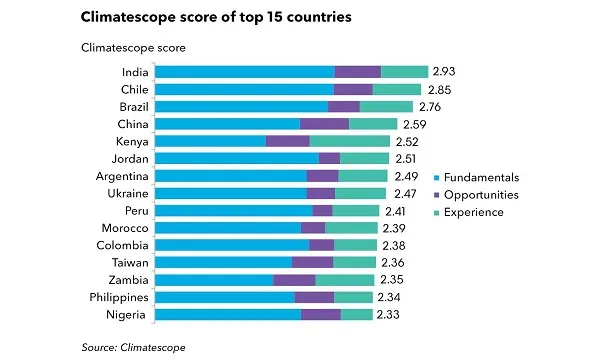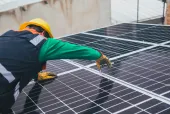
India crowned as top emerging market for clean energy
It now has the largest auctions for clean energy power-delivery contracts.
India climbs to the top spot amongst emerging markets for clean energy investment thanks to its ambitious 175GW renewable energy target for 2022, according to BloombergNEF’s Climatescope analysis. The analysis scored countries according to their Fundamentals, Opportunities, and Experience in clean energy.
India has held the most competitive and largest auctions for clean energy power-delivery contracts. These resulted in the procurement of the equivalent of 19GW in 2018 alone. Together, these developments pushed the country to the top of the table on its Fundamentals score and 3rd on Opportunities in the Climatescope ranking.
Renewables, excluding large hydro, account for 81GW of India’s 356GW capacity. Since 2017, capacity additions from renewables have exceeded those of coal.
“Whilst wind capacity additions of 2.3GW in 2018 were 44% below 2017 levels, solar saw its best year to date with 9GW installed. This included utility-scale, rooftop and off-grid capacity. Wind’s 2018 decline was partly due to a switch in the market from reliance on feed-in tariffs to reverse auctions,” BNEF said.
Another Asian power giant, China, had its clean energy growth streak come to an abrupt end in 2018. Changes to critical policies resulted in new investment sinking to $86b in 2018 from $122b the year prior, and new-build for clean energy dropping to 71GW from 76GW.
“Generous feed-in tariffs that were the norm for much of the past decade are coming to an end. Despite this, China still represents a land of enormous potential for renewables, scoring highest among all Climatescope countries for Opportunities,” BNEF noted.
Although coal still dominates China’s power system, accounting for 54% of capacity and 65% of generation in 2018, both figures are down nearly 10 percentage points from 2012. Wind and solar together now account for 20% of capacity and almost 8% of generation in China, up from just 3% and 13%, respectively, in 2014.
Generation from renewables continues to grow, not only due to growth in capacity, but also because of reduced curtailment. “China’s grid companies have deployed multiple approaches to incorporate more renewables, including generation rights trading, expanded inter-regional power transfer, thermal generator flexibility retrofits and spinning reserves reduction. The result is historically low national average curtailment rates of 7.2% for wind and 3.0% for solar in 2018,” BNEF said.













 Advertise
Advertise











